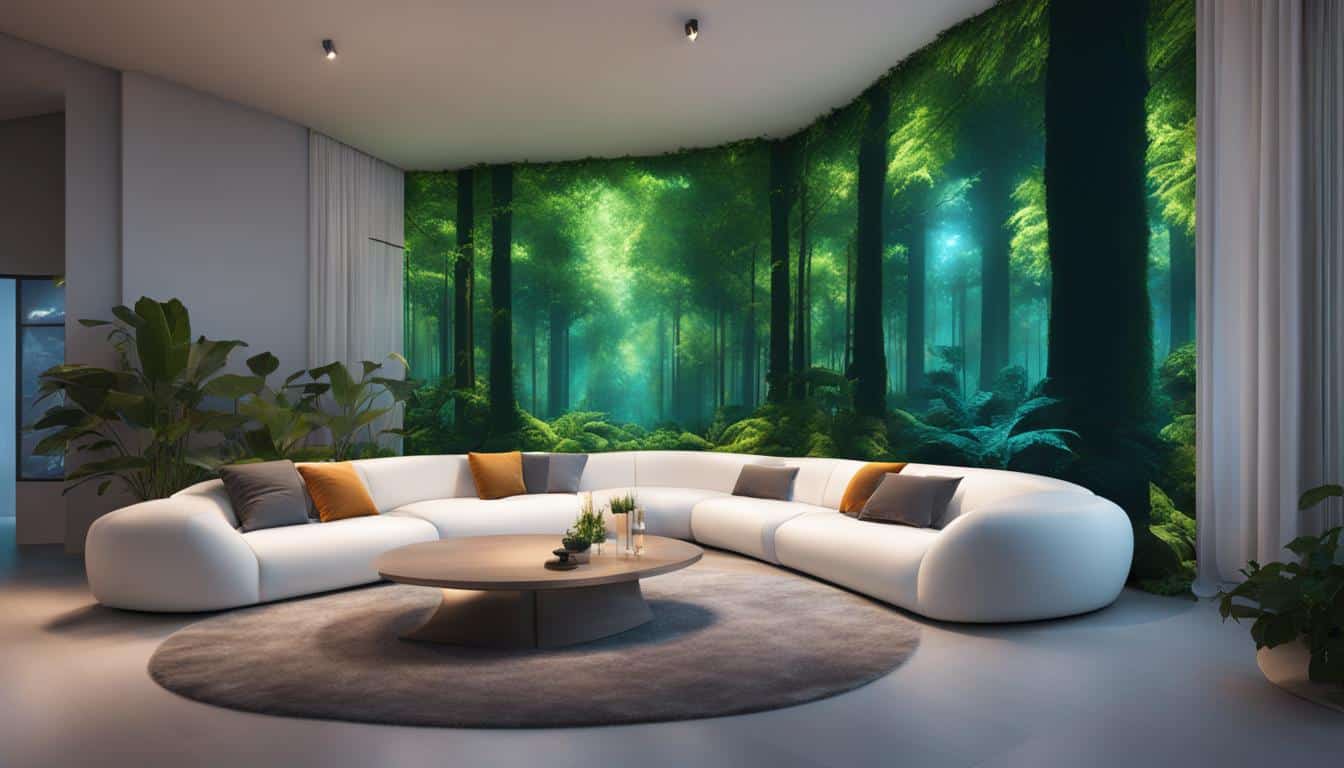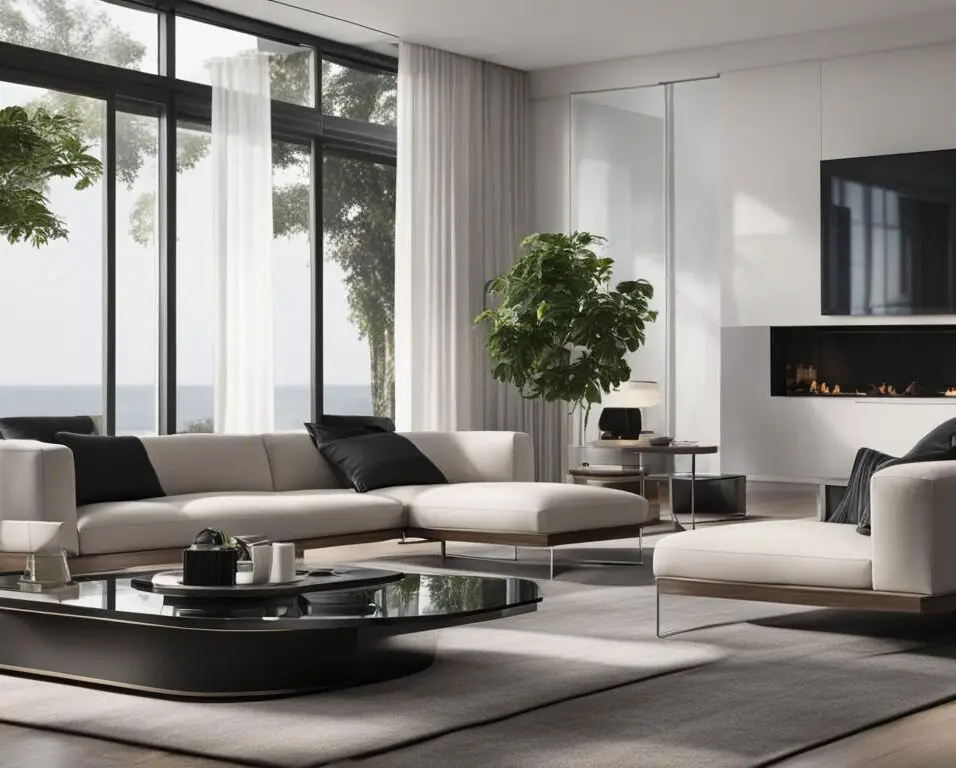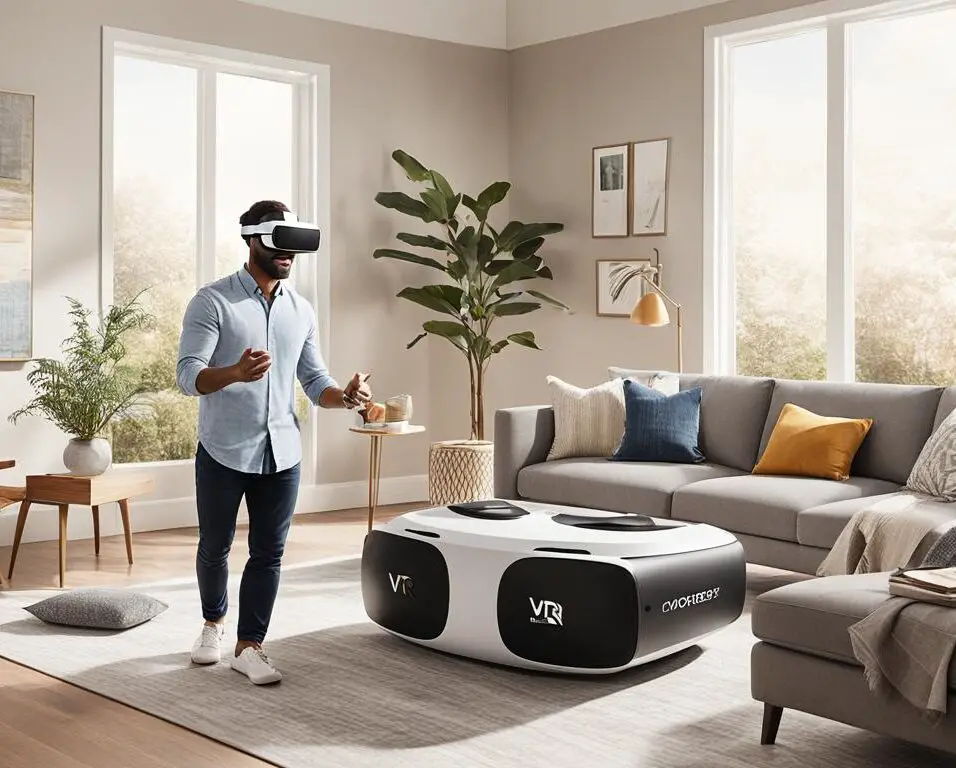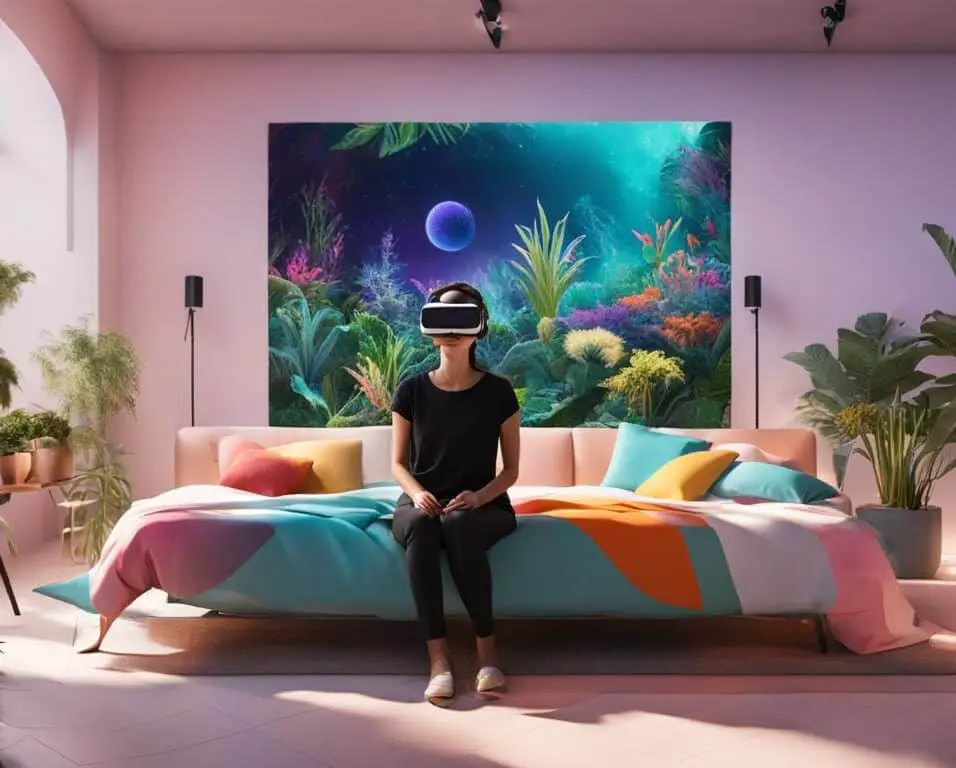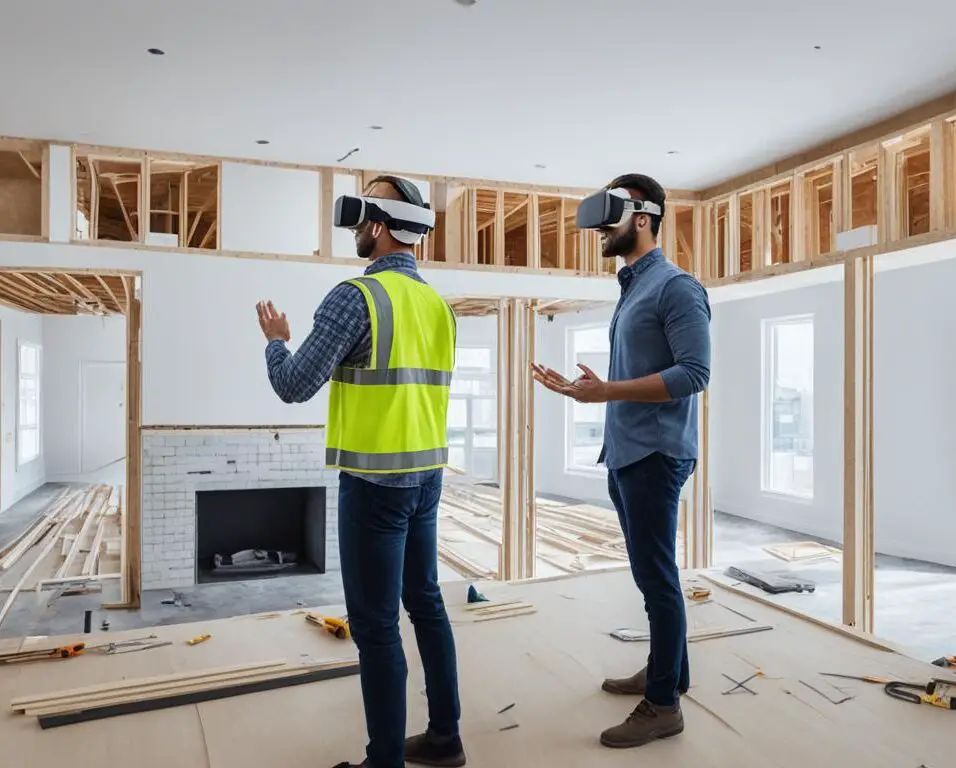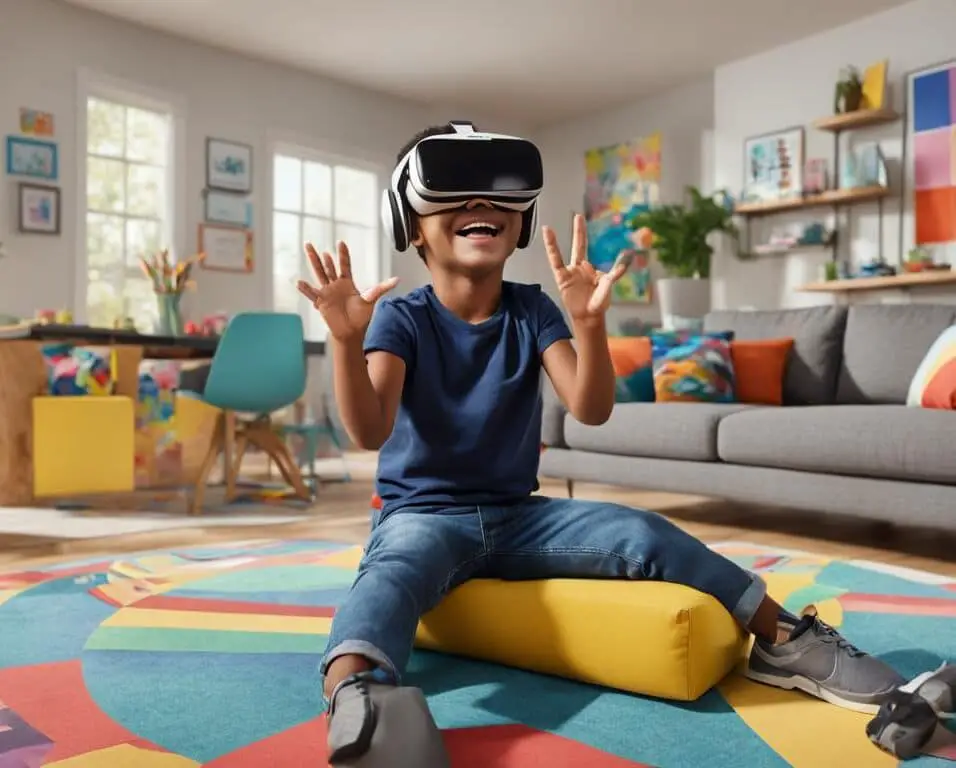Modular Magic: VR in Modern Home Design
Virtual reality (VR) technology is revolutionizing the world of modern home design, offering homeowners a groundbreaking way to customize and visualize their dream spaces. With VR, the possibilities are endless as prefabricated homes come to life right before your eyes. This innovative technology provides an immersive and interactive design experience, allowing you to create the home you’ve always envisioned.
Key Takeaways:
- VR in modular home design allows homeowners to customize and visualize their prefabricated spaces with incredible accuracy.
- Using VR technology, homeowners can make informed decisions about the layout, materials, and finishes of their homes.
- VR enables collaboration with professionals in real-time, making the design process more efficient.
- Utilizing VR helps identify design flaws and potential improvements early on, saving time and cost during construction.
- VR technology is advancing rapidly, promising even more exciting possibilities for the future of modular home design.
The Advantages of VR in Modular Home Design
When it comes to designing modular homes, virtual reality (VR) brings a range of advantages that significantly enhance the overall design experience. VR technology provides homeowners with a more accurate visualization of the final product, allowing them to make informed decisions about the layout, materials, and finishes of their home.
One of the key advantages of using VR in modular home design is the ability to customize the space according to individual preferences. Homeowners can now create homes that truly reflect their unique needs and desires. Whether it’s adjusting the room sizes, rearranging furniture, or experimenting with different color schemes, VR allows for endless customization possibilities.
Moreover, VR plays a crucial role in identifying any potential design flaws or issues before construction begins. By immersing themselves in a virtual environment, homeowners and designers can spot problems that may have otherwise gone unnoticed. This early identification of issues saves time and money, avoiding costly revisions or modifications during the construction phase.
Let’s delve deeper into the advantages of VR in modular home design:
- Accurate Visualization: VR technology provides a realistic and immersive experience, enabling homeowners to visualize their future homes in detail. With 360-degree virtual tours, they can explore every corner and get a sense of space before it’s even built.
- Customization: VR allows homeowners to customize their modular homes according to their personal preferences. From selecting room layouts to choosing materials, finishes, and fixtures, every aspect of the design can be tailored to meet specific needs.
- Design Validation: VR helps validate design choices by allowing homeowners to see how different elements come together. They can experiment with various design options and get a feel for how the space will look and function.
- Efficiency and Cost Savings: By identifying design flaws and making necessary modifications in the VR environment, homeowners and designers can avoid costly changes during the construction phase. This leads to substantial cost savings and ensures a smooth building process.
- Improved Collaboration: VR facilitates seamless collaboration between homeowners, architects, and designers. Through virtual meeting rooms and shared virtual environments, stakeholders can communicate, exchange ideas, and make real-time adjustments, resulting in a more efficient design process.
With its ability to provide accurate visualization, customization options, design validation, cost savings, and improved collaboration, VR is undoubtedly transforming the way modular homes are designed. By harnessing the power of this technology, homeowners can bring their dream homes to life with unparalleled precision and confidence.
The Process of Designing with VR
In the world of modular home design, the use of virtual reality (VR) technology has brought about a new and exciting way to create and visualize spaces. The process of designing with VR offers a seamless and immersive experience, allowing homeowners to actively participate in the creation of their dream homes. Through virtual walkthroughs and realistic experiences, VR enables a more detailed and accurate understanding of the final design.
To start the process, a digital model of the modular home is created. This model serves as the foundation for the design and can be customized according to the homeowner’s preferences. Using specialized VR software or platforms, the homeowner can make changes to the layout, materials, and finishes, ensuring that every detail aligns with their vision.
Once the design is finalized, the homeowner can take a virtual walkthrough of the space. This involves wearing a VR headset and being transported into a digital representation of the future home. The virtual walkthrough provides a realistic experience, allowing the homeowner to immerse themselves in the environment and get a true sense of the space.
During the virtual walkthrough, the homeowner can explore every corner of the home, examining the layout, the flow of space, and the placement of furniture and accessories. This helps in making design decisions and ensures that every aspect of the home meets the homeowner’s expectations.
Through the process of designing with VR, homeowners can experience a realistic representation of their future home before it is even built. The immersive nature of VR technology enhances the design process, making it easier to envision the final result and make informed decisions. This level of detail and interactivity brings a new level of excitement and confidence to the homeowners and revolutionizes the concept of home design.
Collaborating with Professionals through VR
Collaboration is key in any design project, and VR technology is taking collaboration to new heights in the world of modular home design. With the help of VR collaboration tools, professionals such as architects, designers, and builders can seamlessly work together in a virtual environment, enhancing communication and efficiency throughout the design process.
By leveraging VR collaboration tools, professionals can make real-time changes, exchange ideas, and provide feedback to ensure the final design meets the homeowner’s expectations. This eliminates the need for multiple physical meetings, saving time and resources.
In addition, VR enables homeowners to actively participate in the design process, allowing them to provide feedback and make decisions in a collaborative manner. With the ability to visualize the design in a virtual environment, homeowners can better communicate their preferences, resulting in a more personalized and satisfying end product.
Advantages of Collaborating with Professionals through VR:
- Seamless Communication: VR collaboration tools provide a platform for professionals to communicate and exchange ideas in real-time, fostering a more efficient and collaborative workflow.
- Enhanced Visualization: Through VR, professionals can present designs in a more immersive and realistic manner, helping homeowners better understand and visualize the final result.
- Efficient Decision-Making: With the ability to make real-time changes and receive immediate feedback, professionals and homeowners can make informed decisions more efficiently, streamlining the design process.
“VR collaboration tools allow professionals and homeowners to bridge the gap between imagination and reality, working together to create the perfect modular home design.” – Jane Anderson, Lead Architect
Collaborating with professionals through VR not only enhances the design process but also fosters a sense of trust and transparency between all parties involved. With seamless communication and enhanced visualization, the collaborative efforts result in a modular home design that truly reflects the homeowner’s vision.
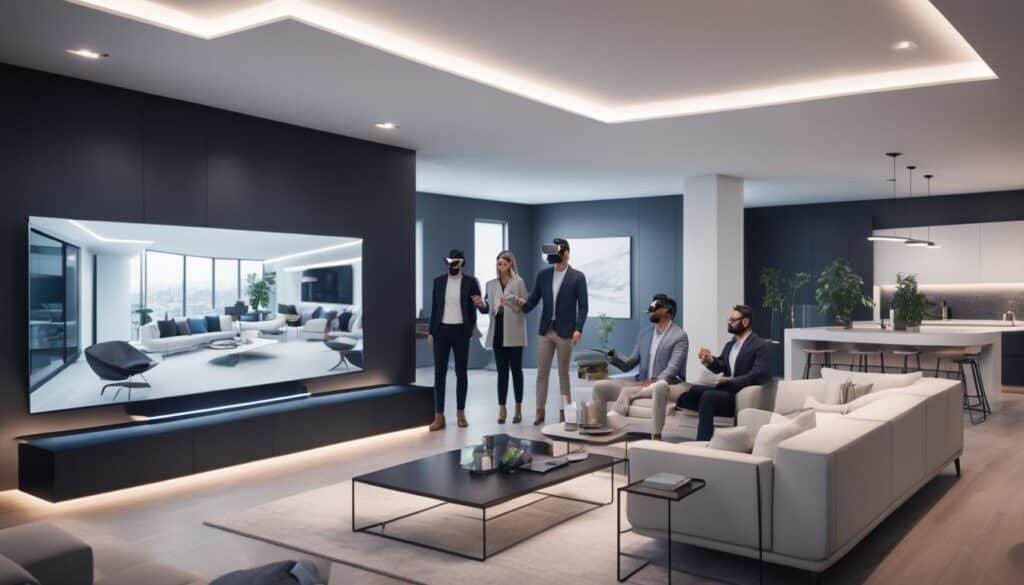
In the next section, we will explore the sustainability and cost-saving implications of using VR in modular home design, and how it contributes to creating more efficient and environmentally friendly homes.
Sustainability and Cost Savings with VR
The integration of VR technology in the modular home design industry offers many advantages, including sustainability and cost savings. By leveraging VR simulation, designers can optimize space utilization and energy efficiency, resulting in more sustainable designs that minimize environmental impact. This innovative approach allows homeowners to visualize and experience the eco-friendly features of their future homes before construction begins.
Virtual reality enables designers to identify potential design flaws or inefficiencies early in the process, eliminating the need for costly changes during construction. By conducting virtual walkthroughs and simulations, designers can detect and address any issues, ensuring a smoother and more efficient building process.
Efficient design is another significant outcome of incorporating VR technology into modular home design. With VR, homeowners and designers can collaborate more effectively, making real-time changes and decisions in a virtual environment. This streamlines the design process, saves time, and reduces costs associated with multiple physical meetings and revisions.
Furthermore, VR allows for the exploration and testing of various design options, materials, and finishes virtually, reducing waste and saving resources. Through these digital simulations, designers can make informed decisions about the most aesthetically pleasing and cost-effective choices, contributing to both sustainability and budget optimization.
Benefits of Sustainability and Cost Savings with VR:
- Optimized space utilization and energy efficiency
- Early detection of design flaws and inefficiencies
- Streamlined collaboration and decision-making
- Reduction of waste and resource consumption
- Budget optimization and cost savings
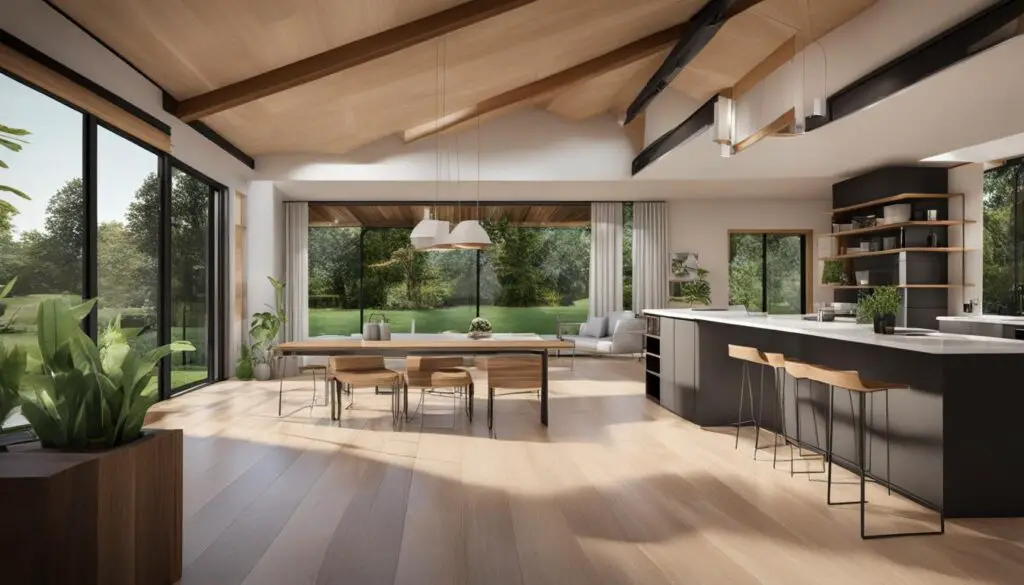
| Benefits | Explanation |
|---|---|
| Optimized space utilization and energy efficiency | VR simulation allows for the exploration of different design options, leading to efficient use of space and integration of sustainable features. |
| Early detection of design flaws and inefficiencies | By conducting virtual walkthroughs and simulations, design flaws can be identified and addressed before construction, avoiding costly changes later on. |
| Streamlined collaboration and decision-making | VR enables seamless communication between homeowners and professionals, facilitating real-time changes and efficient decision-making. |
| Reduction of waste and resource consumption | By allowing designers to test different materials and finishes virtually, VR minimizes waste and optimizes resource usage. |
| Budget optimization and cost savings | The identification of design flaws and efficient decision-making contribute to cost savings during the construction process. |
By leveraging VR technology, the modular home design industry can achieve sustainability goals, reduce costs, and provide homeowners with environmentally friendly and cost-effective living spaces. The efficient design process facilitated by VR not only benefits individuals but also contributes to a more sustainable and greener future.
Future Implications and Trends
The future of VR in modular home design holds immense potential for advancements and exciting trends. As technology continues to evolve at a rapid pace, we can anticipate the emergence of more sophisticated VR tools and platforms that will enhance the design experience for homeowners. These advancements will revolutionize the way we visualize and customize our dream homes, creating a more immersive and interactive design process.
Increased Access to VR
One significant future implication is the increased accessibility of VR in home design. As the technology becomes more widespread and affordable, more homeowners will have the opportunity to harness its benefits. This accessibility will empower homeowners to visualize and customize their dream homes, making informed decisions about the design and layout.
Integration of Augmented Reality (AR) and VR
The integration of augmented reality (AR) with VR is another exciting future trend in modular home design. While VR provides a fully immersive experience, AR adds real-time elements to the virtual environment, allowing homeowners to overlay virtual objects onto the physical space. This integration will enable homeowners to experiment with different design elements and visualize how they will look in their actual living spaces.
Design Collaboration and Communication
Advancements in VR technology will also facilitate seamless collaboration and communication between homeowners, architects, and designers. VR collaboration tools will enable real-time interactions, allowing all stakeholders to work together virtually, regardless of their physical location. This streamlined communication process will lead to more efficient project management and ensure that everyone involved is on the same page.
Enhanced Realism and Visualization
Future advancements in VR will focus on enhancing the realism and visualization capabilities of the technology. With improved graphics, lighting, and textures, virtual environments will become even more lifelike, enabling homeowners to experience their future homes in incredible detail. The realistic portrayal of materials, finishes, and spatial arrangements will enable more informed decision-making and create a truly immersive design experience.
VR Trends in Modular Home Design
| Trend | Description |
|---|---|
| Enhanced Interactivity | The future of VR in modular home design will focus on increasing interactivity, allowing homeowners to interact with virtual elements and make real-time changes to their designs. |
| Intuitive Design Tools | Advancements in VR technology will lead to the development of more intuitive design tools that are user-friendly and accessible to homeowners without specialized design knowledge. |
| Efficient Design Iterations | Future VR platforms will enable faster design iterations, allowing homeowners to explore multiple design options and make changes quickly, saving time in the design process. |
| Seamless Integration with Building Information Modeling (BIM) | As VR technology evolves, it will seamlessly integrate with Building Information Modeling (BIM) software, enabling smoother transitions from the design phase to construction. |
| Virtual Home Tours | VR technology will enable virtual home tours, allowing potential buyers to experience and explore modular homes remotely, saving time and effort in the home buying process. |
In conclusion, the future of VR in modular home design is filled with possibilities. With advancements in VR technology, increased accessibility, the integration of AR, and enhanced collaboration tools, homeowners can expect a more immersive and interactive design experience. The ability to visualize and customize their dream homes in virtual reality will revolutionize the industry and empower homeowners to create spaces that truly reflect their unique tastes and preferences.
Conclusion
VR in modular home design has revolutionized the industry, offering homeowners a unique and immersive experience in the design process. With the ability to customize and visualize prefabricated spaces before construction, homeowners now have more control and can make informed decisions about their dream homes.
By harnessing advanced VR technology, homeowners can explore every detail of their future homes, ensuring that the layout, materials, and finishes align perfectly with their preferences and needs. This immersive and interactive design experience not only enhances customer satisfaction but also saves time and resources by identifying any design flaws or issues early on.
Looking ahead, as VR technology continues to advance, we can anticipate even more possibilities and innovations in the field of modular home design. The integration of augmented reality (AR) and other emerging technologies holds tremendous potential for further enhancing the design and customization process, making it accessible to a wider audience.
FAQ
What are the advantages of using VR in modular home design?
VR allows for a more accurate visualization of the final product, customization according to individual preferences, and identification of potential design flaws before construction begins.
How does the process of designing with VR work?
The process starts with creating a digital model of the modular home, which is then imported into a VR software or platform. Homeowners can make changes and customize the space to their liking, and then take a virtual walkthrough to experience a realistic representation of their future home.
How does VR facilitate collaboration between homeowners and professionals?
VR collaboration tools enable architects, designers, and builders to work together seamlessly in a virtual environment. Real-time changes and idea exchange can be done without the need for multiple physical meetings, allowing homeowners to actively participate in the design process.
How does VR contribute to sustainability and cost savings in modular home design?
VR simulation helps optimize space utilization and energy efficiency, leading to more sustainable designs. It also helps identify potential design flaws or inefficiencies before construction, reducing the need for costly changes during the building process.
What can we expect for the future of VR in modular home design?
As technology advances, we can expect more sophisticated VR tools and platforms to enhance the design experience. VR may become more accessible to a wider audience, and the integration of augmented reality (AR) and other emerging technologies will open up even more possibilities for design and customization.
How does VR revolutionize the design experience for homeowners?
VR allows homeowners to customize and visualize their prefabricated spaces before they are built, giving them more control over the design process. They can make informed decisions and see every detail of their dream home come to life in an immersive and interactive way.



